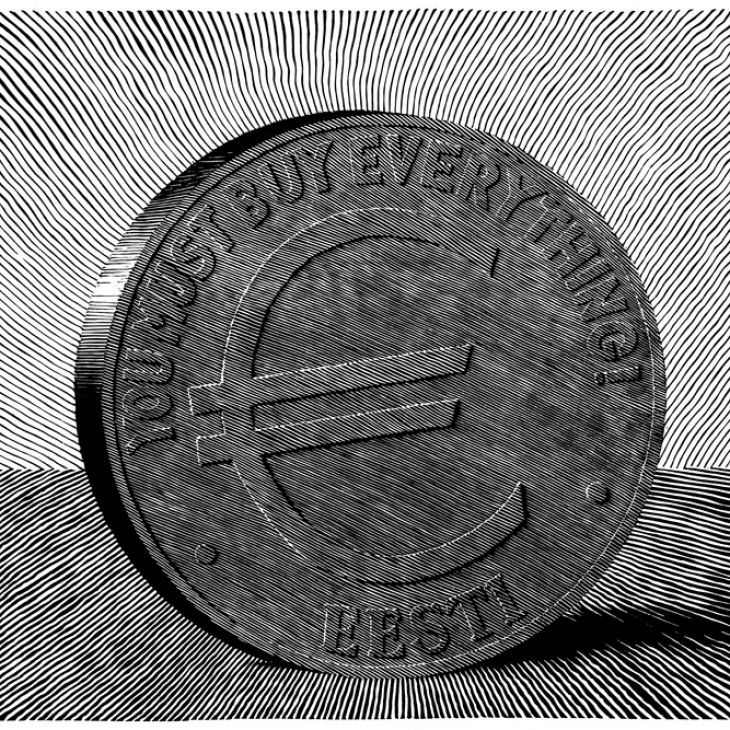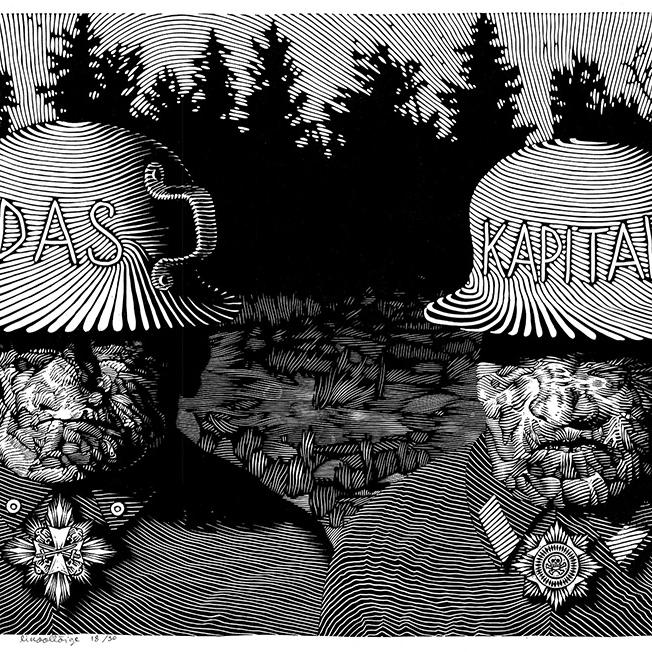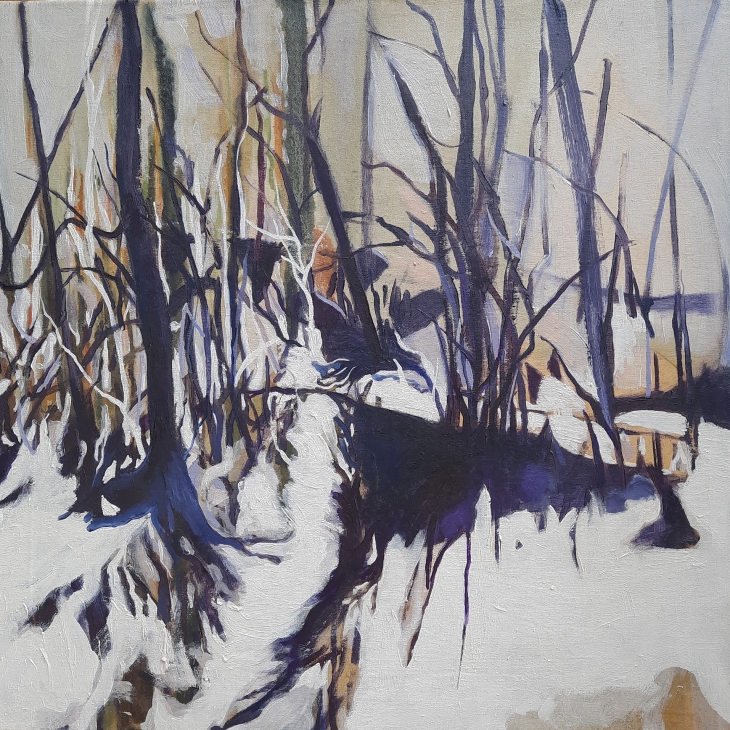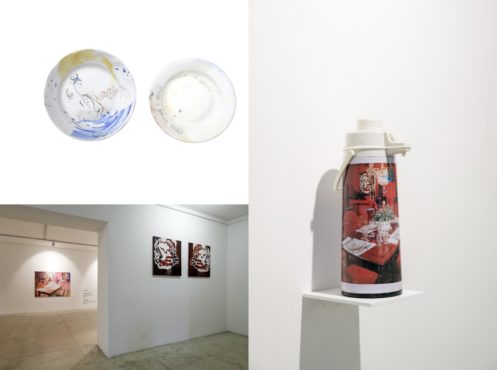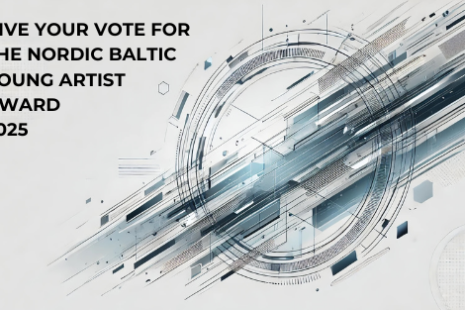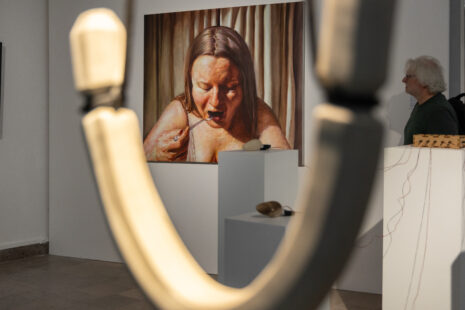Latvian painter Elina Vitola, who graduated Art Academy of Latvia just last spring, was awarded with the main prize of Nordic & Baltic Young Artist Award (NBYAA) a few weeks back. The winning piece of art was a 20 m long and included a sofa. What was Elina’s trigger in creating such a piece, how she discovered painting and a route to art, who are her role models and what are her thoughts about collecting art? NOAR.eu had a chance to ask it all.
First of all, congratulations! How do you feel about winning the main prize of NBYAA – was it a surprise or was It something you expected?
I feel great – the only thing I have ever won before is a toothbrush, and I was 17 then. So yes, winning the award is certainly a surprise.

Common Issues in Painting and Every-Day Life 5, 2018
By Elīna Vītola
Your participating work in NBYAA was about 20 m long including a sofa – not a traditional painting. How did you come up with this crazy idea, to this solution. How was the creation process?
Oh, the story is almost as long as the painting – are you ready to listen to it? The art training I have had has always been based on studying nature and depicting it. As I decided to take up abstract painting, I had no tradition or education to start with. I started to look for abstraction that already exists in the environment I am at. One of such things are multicolored upholstery fabrics which were are very popular in eastern Europe for their practicality, whose patterns often mimic abstract brushstrokes. I started collecting pieces of furniture and images and repainting them as abstract paintings.
Also, whilst studying the students often hear an advice to paint as much as they can in order to develop as an artists. I often heard students around me presenting their work as based in inner feelings, indescribable expression and matters of soul. I felt compromised that I don’t possess such ability to paint without an actual source. Outside of academy I saw artists exhibiting series of works that constantly repeat themselves from show to show. I decided to paint this 20 meters long painting with a pattern, taken from outdated sofa fabric which repeats constantly in full length. I painted the first segment by following the found imagery, but all the rest is painted by looking only at the previous segments of the painting itself. This way it was meant to reach all goals – to get better at art by painting a lot, to find the unnamable expression and to learn to repeat myself.
Obviously, the goal at the end of 20 meters of the painting was to be a successful artist. It is stressed that success in art is connected to sales, so the ultimate goal was to have the painting hanging over someone’s sofa. I decided, that the painting could go straight on the sofa itself. After finishing the 20 meters long painting I painted another one. It was representing all I achieved during the previous 20 meters. I took the fabric to seamstress who made it into sofa cover. So in final installation you can see the first meter that could be seen as experimental and the final established painting on the sofa that is supposed to be the ultimate professional product. But all the way between those two is rolled into the roll and inaccessible to the viewer.
It sounds like a tremendous amount of work. How long was the process?
The first step was to get the money for materials. I tried to sell every painting I had on Christmas markets, few of them were sold, but unfortunately with discounts. I took on many odd jobs and asked my family for money on Christmas, so in couple of months I could buy materials and start painting. I moved from studio in academy to my home as I had to build weird supporting tools, so I could roll the blank canvas further and simultaneously let the painted areas to dry.
I painted for about five months, and emotionally it was the strangest work I have ever done, because every morning I woke up and went to paint and I had to ask every other art related idea that popped in my mind to leave, because I was too busy painting the roll. In a couple of months, I thought maybe after finishing it I will no longer be an artist, because I have trained my brain to get rid of ideas. But actually, I see the sofa as pretty traditional painting – it’s still oil paint on canvas, and also the idea of actually being in the painting is ancient.
Has art and being an painter always been the only option for you? How did you find your way into the field?
My got interested in painting when I was about 4 years old – I found two books in my parents’ bookshelf full of pictures of extraordinary beauty – one was about still life painting in soviet Latvia, another one pastel painting. At the age of eleven I accidentally found out that art is not only beautiful, but it also could express powerful ideas, I got hooked. I got lucky as I was able to start studying painting in Janis Rozentāls Riga Art school at the age of twelve, which I finished with painter’s diploma. But that didn’t lead me straight to more painting – after school I thought there must be other interesting things in life – it took me a couple of years to realise that there isn’t. I regret those wasted years with all my heart. I have had affairs with photography and sculpture, but I always come back to painting for it’s special place among other arts and because I just know it so well that it’s hard to be apart.
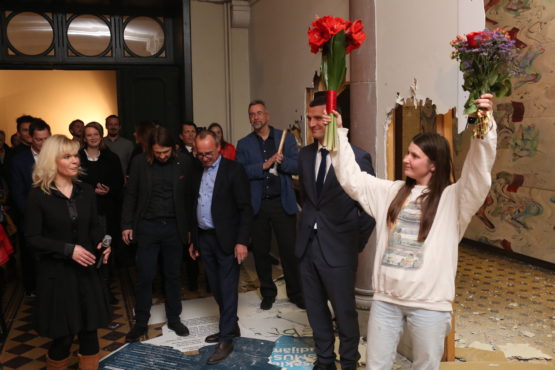
Elina receiving NBYAA main prize in Art Academy of Latvia
What inspires you to create your pieces, is it a struggle to find inspiration?
I don’t work with inspiration – the hard part is to fish out the good ideas and to let go of the bad ones. But you never know – maybe it’s the other way around. I get a lot of ideas from the environment I’m at – in academy it was the art education, now it’s the art world.
What would like views/audience to see and understand when they look at your works?
I have no idea. I wonder why do I keep hearing this question everywhere – is it number 3. In a book what to ask to an emerging artist? I paint, because I am very happy while I do it – when I don’t do it I am less happy and this process results in finished pieces.
If the work I have made finds an audience, I myself or someone else can provide some explanation, but this explanation cannot express the same information what is inside the work itself thus I have no power upon the seeing or understanding of the audience. I have no competence in this as I did not create the work for looking at it or understanding it myself. I believe there are many artists who base their practice in thinking about the audience, but it is not my case and I see this question as asking mother why her sons wife loves him.
In your artwork you like to use other materials beside classic canvas – we could see painted hot water flasks and clothes. What’s up with that?
I think of myself as a doomsday prepper in art. I often wonder what would happen if my family confronts me and makes me get a real job and I cannot paint anymore. What if everyone’s families do that? What if there’s no art by living artists anymore? I feel that in art-apocalypse scenario I could smuggle those things that pretend to simple commodities with me in the art-afterlife.
No, actually that’s more of a joke. I think a lot about value in art and in life and the hierarchies – painting taking the highest status and track suits the lowest. I’m interested in blurring those boundaries.
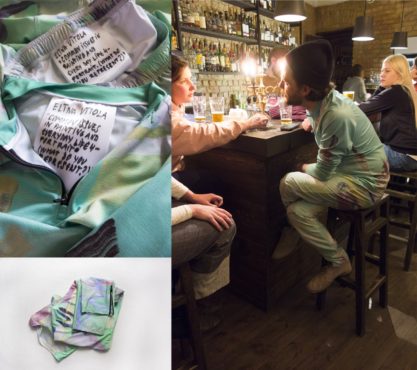
Who are your role models? Any artists you admire?
There are many. I admire every artist who finds a chance to make art every week. On daily basis I admire my friends, as I am very lucky to have befriended amazingly talented artists. I have the biggest respect for medical doctors – I value human life most of all things.
What could we hear about you in next 1-2 years? What are your future plans?
This is a very tricky one. As I am very skeptical about the state of artworld and art-economy and completely mystified by institutional theory thus it’s hard for me to know what could you hear about me. Very little of that is in the hands of artists – the destinies are decided by curators and other art workers, pure luck and random. I know personally a painter who works on regular basis but whose work has never been recognised and it could happen to me in couple of years. On the other hand – once an artist has nailed the luck, random and other things I mentioned earlier, they have to face the pressures of exhibition plan, the fear of saying no and lack of time for experimentation. So I would say the best way to hear from me in couple of years would be to ask me how am I doing personally. My future plans mostly include painting though.
If you would be about to start collecting art, who’s pieces of art would you like to get for your own collection?
It’s true that many artists own works of art by other artists, including myself. I have amazing pieces of photography in my house – works by Ivars Grāvlejs, Lukáš Jasanský and Martin Polák, Camille Laurelli. But I haven’t acquired those by monetary means.
If I would suddenly have all possible, I would rather create something like Villa Santo Sospir – a house filled with murals and monumental pieces, or I would buy a building which houses some existing soviet monumental piece. But also – no. If I would have the means to collect art, I wouldn’t. I think there are better ways to spend money for supporting artists which would reach wider range of people than collecting.
Currently Elina is preparing a show for Careva Contemporary gallery. She posts her works with a considerable delay in her tumblrelinavitola.tumblr.com and on her instagram @instaeliina.
Check out Elina’s art available in NOAR

